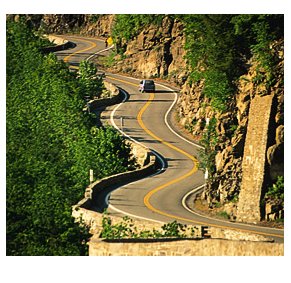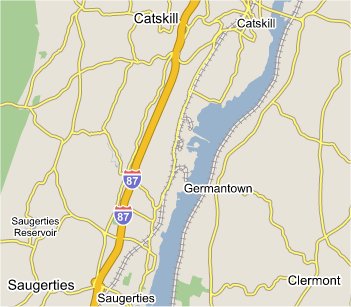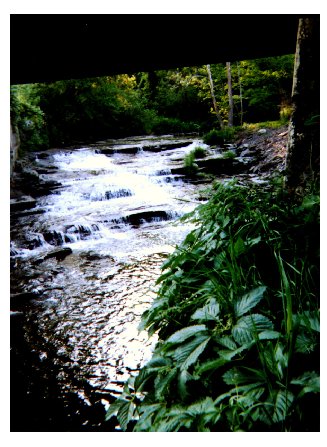June 21, 2005
END OF THE ROAD... FOR CHRIS

Time: 4:10 p.m.
Place: Catskill, N.Y.
Alan: We are in the village of Catskill in Green County, N.Y., and I am at Mile 118.

It looks like the end of the road for Chris. He's been a fantastic bike partner today during some serious Hudson Valley road pounding uphill at 10, 15 and 20 miles at a clip. It was really a great experience cycling with Chris. I'm glad he was able to share the day with me. It meant a lot.
Anyway, we're in the village of Catskill and Chris is going to have one of his daughters pick him up. I'm going to follow through across the Rip Van Winkle Bridge. I'll be going up the east side of the river for about 30 or 40 miles before I cross over to Albany.

Chris is going to give you a final thought here:
Chris: It was a great ride at a great pace. Couldn't ask for a better partner to go bike riding with. We've seen a lot of beautiful things you could never see from a car. It was a well-worthwhile trip for me even though I'm only doing half of what Alan is doing. I wish I could do the whole thing, but I'm just glad I got to spend the time with him that I did.
That's it for me. I'm headed back home to take a shower.
Take care.
Alan: I think Chris brought up a good point about when you're on a bicycle you kind of go at pace where you can see things that you otherwise wouldn't see. It's been fun meeting a lot of people along the way.
I'll give you a call from none other than Stewarts ice cream convenience store in Hudson, N.Y.
Editor's Note: A little background about the Rip Van Winkle Bridge:
In 1930, Ellis W. Bentley, a New York State Assemblyman from Windham, proposed legislation to appropriate $450,000 to study a bridge across the Hudson River between Catskill, Greene County and Hudson, Columbia County. Franklin D. Roosevelt, at that time the governor of New York, vetoed the bill, arguing that the state did not have the authority to finance construction. Instead, Roosevelt recommended the creation of a separate entity, the New York State Bridge Authority, to sell construction bonds. In 1932, the new authority applied for $3.4 million in loans from the Reconstruction Finance Corporation (RFC), a Depression-era agency, in order to build the Catskill-Hudson Bridge.
Designed under the auspices of the New York State Department of Public Works (NYSDPW), the proposed bridge featured a main cantilever span of 800 feet, side cantilever spans of 470 feet, and an eastern approach comprised of ten 330-foot-long truss spans. From end to end, the Catskill-Hudson Bridge, named after the Washington Irving character Rip Van Winkle, measures 5,040 feet long.
Controversy surrounding condemnation proceedings on the western approach delayed construction. The Catskill approach was to be built on land owned by Thomas Cole, an artist of the Hudson River School. The state was prepared to pay up to $15,000 for the land, or condemn it if necessary. However, Thomas Cole's heirs believed the historic value of the land should bring a price of at least $100,000. To expedite construction, the state decided instead to locate the approach to north of the Cole property.
Construction of the Rip Van Winkle Bridge in April 1933. To haul materials to the construction site, roads were constructed on the western shore, a temporary narrow-gauge railroad was built on the eastern shore. In addition, cranes were used to hoist steel and other materials from barges in the Hudson River. Two cranes moved back and forth, putting steel girders in place, followed by men who would bolt and rivet them into place.
By September 1934, all 13 steel piers were erected, as were seven of the individual truss spans. Two months later, following a strike that delayed construction, work resumed on the three remaining individual truss sections. The last link was installed on January 18, 1935, when the two arms of the main cantilever span were jointed by the use of sixteen 300-ton hydraulic jacks.
During the spring of 1935, workers installed the two-lane roadway, and completed the Dutch-colonial-style toll plaza and administration building. The Rip Van Winkle Bridge opened to traffic on July 2, 1935, at a cost of $2.4 million and three lives. When the bridge opened, a toll of 80 cents per passenger car, plus 10 cents for each passenger (up to a maximum total of $1) was charged.